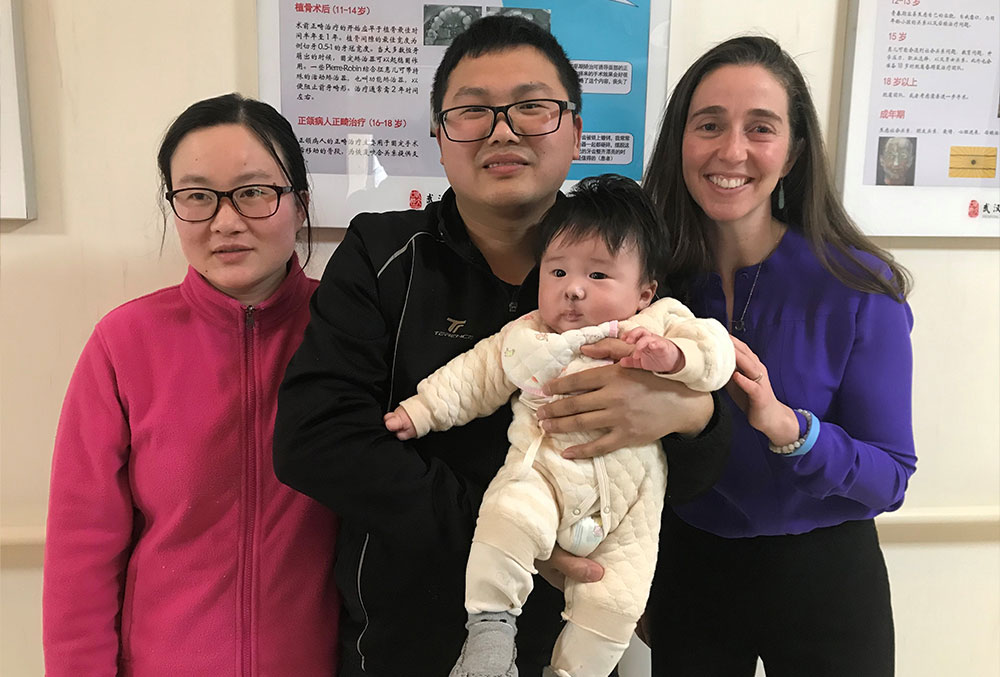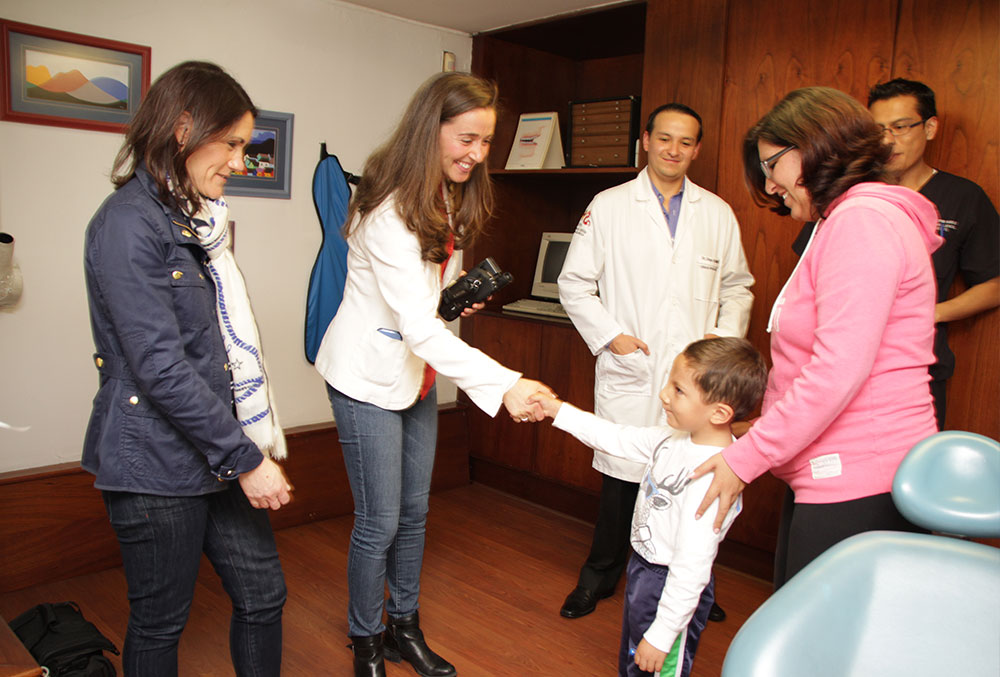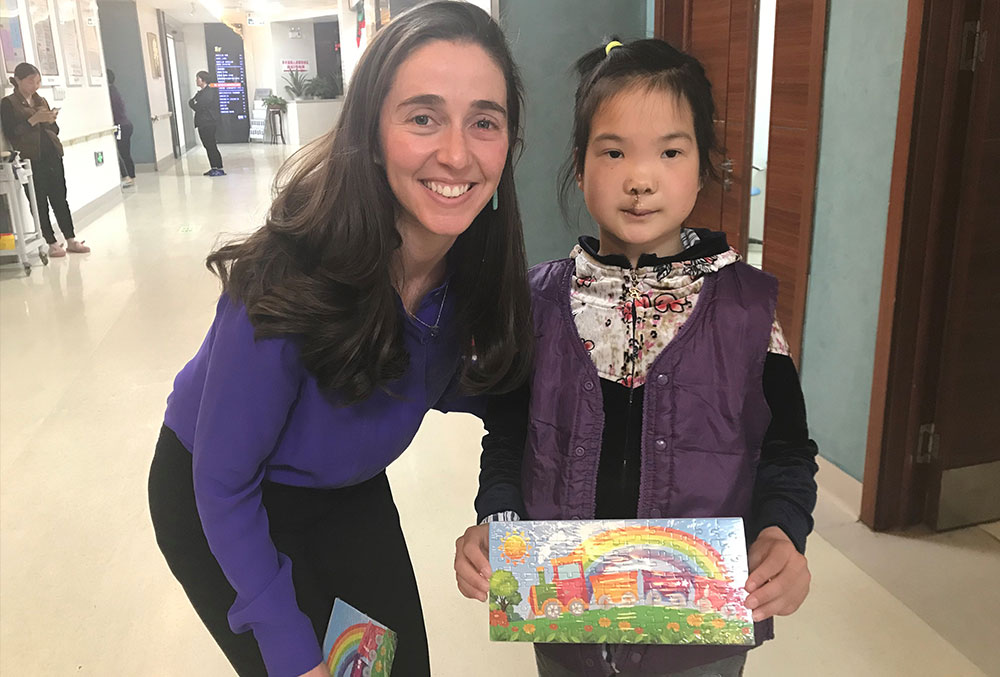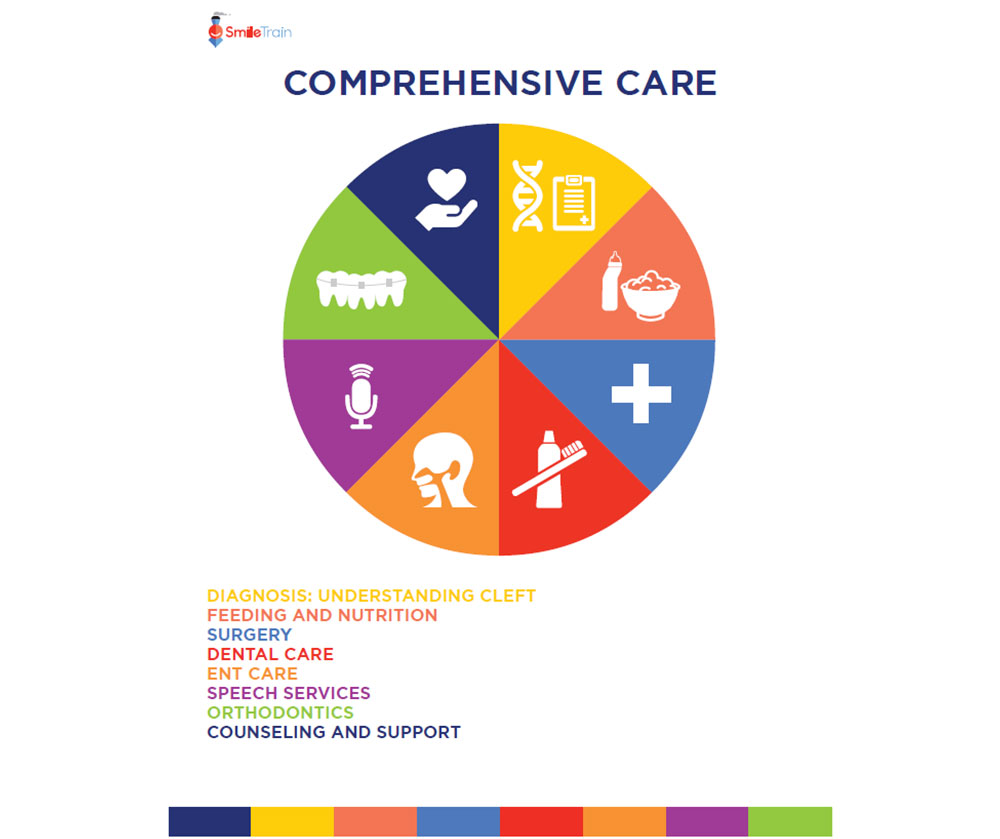Pamela Sheeran on Smile Train’s Investment in Expanding Non-Surgical Cleft Care

Pamela Sheeran, MPA is Smile Train’s VP of strategic programs and partnerships. In this position, she oversees our comprehensive cleft care programs, or the essential non-surgical services such as nutrition support, speech therapy, orthodontics, and more that people with clefts need to not just live, but truly thrive. We recently caught up with her to discuss how her journey to Smile Train taught her just how transformative these programs can be to patients, families, healthcare systems, and communities; Smile Train’s plan to make them accessible to all; and much more.
Tell me about your journey to Smile Train. What did you study in college and how did you end up specializing in comprehensive cleft care?
I went to college at the University of Virginia (UVA) thinking I wanted to go into orthodontics. I was really enjoying the science classes, and my first year, I happened to sign up for this small seminar on international health. I arrived on the first day and realized that I shouldn’t have been there. It was an international students’ seminar! But the professor welcomed me with open arms, and this was my first intro to global health and the global inequalities in children’s access to care. I was hooked — it left me so shocked and so motivated to learn more and get involved to make a difference.
I continued on my pre-dental track at UVA, but when it came time to choose a major, I chose this interdisciplinary program called Human Biology, which took the sciences and applied them to everyday life. I chose it because I was drawn to learning more about health systems and access to care, not just the care or treatment itself. We had a lot of debates about the linkages in public policy, law, and healthcare in the US, but the conversations left me frustrated. I would think, “Why aren’t more people talking about the status of the world’s children? Why is this not mainstream news? Children in the developing world don’t have access to basic water, food, and healthcare.” At that point, there was no turning back for me — this is what I wanted to purse as a career.
I spent every spring break and summer thereafter volunteering at an orphanage at the border of the Dominican Republic and Haiti. I got involved in every class, seminar, and club that related to global health and children’s rights.
I had some contacts in Guatemala, so after college I picked up and moved there to work for a few NGOs. That experience gave me a whole different perspective on what it is like to work for organizations that are trying to open access to healthcare for children.
I came back and enrolled at NYU in a Master of Public Administration program specializing in health systems administration with a focus on global health. I started the week after coming back from Guatemala, and that same week I saw a posting for a job at Smile Train as a receptionist. I figured I could use some job experience and I thought the organization sounded interesting, so I applied. I got an interview, walked in the door and Janet Blackwood, who is now our Senior Director of Grants Management, said, “I saw your resume. Would you like a job on the Programs team?”

Did you have any experience with clefts before starting at Smile Train?
I didn’t know what a cleft was when I started. But when I told my mom about my new job and what Smile Train does, she got very emotional. It turns out, she was trained to be a speech therapist and had learned about children with clefts and really loved the work. But she had my twin sisters right when she was about to finish her degree and never got to finish her program or pursue a career in speech therapy.
How did you move from that administrative role to overseeing Smile Train’s programs in the Americas? How has that experience helped you in your current position?
When I was in the administrative role on the Programs team, I would keep a particular eye on the programs in South and Central America because I spoke Spanish. We had just hired a lot of our international staff: There were people in Brazil and in Mexico that I often was in touch with, but when they left, the partner hospitals they oversaw no longer had someone on the ground from Smile Train to support them. So when I stepped into the role, I wanted to reassure them that this situation was temporary and that we were there for them. It ended up being such a wonderful process to be able to visit the partners on the ground and explain who we are as an organization and what it means to be part of it. I got to say, “Smile Train believes in what you’re doing. Let’s find ways to grow your program together, add some pilot projects, and make sure you have what you need.” Then we hired more local Smile Train staff than we had before, many of whom are still here.
What was really neat was that while I was in that position, Smile Train was doing a deep-dive into its work — this was 2016 and we were approaching our 15-year anniversary and our one millionth patient — and we were strategizing the future of our organization. By that point, I had spent the past five years or so traveling to Latin America, then coming back and telling the stories and showing the patient photos and talking about our partners’ work, and it all built into the same story of why offering comprehensive cleft care was so important. My colleagues in our other regions were telling these stories too, and our work paid off when Smile Train included comprehensive cleft care in our values statement for the first time that year. Shortly after this, I transitioned out of my role as Regional Director for the Americas into the position of Vice President of Comprehensive Cleft Care. This was a new position for Smile Train so we could build the proper structures, systems, and network of advisors to support the growth of comprehensive cleft care programs globally.

How does building comprehensive cleft care programs around the world compare to building surgical capacity? What are the unique challenges here?
When you’re building capacity for comprehensive cleft care programs, it can be hard to retain the professionals you train, because once they have the skills, they’ll understandably want to keep moving on and advancing their careers to new places. That’s one challenge. Another is reporting on these programs — because comprehensive cleft care is ongoing, I think it can be hard for our partner medical professionals to balance their reporting needs with our need to support them in a way that encourages quality of care and accountability.
How have we found solutions to those issues?
The two most effective solutions we’ve found so far are technology and relationship-building. On the tech side, we’re constantly updating Smile Train Express, our proprietary database of record for all our medical files, and staying on the front lines of technology to always find more efficient solutions. But all the tech in the world is useless without having those relationships with our partners so we can continuously train them and get better reporting. And these aren’t separate categories either, because the only way our partners are going to be able to access research opportunities to better understand their work, outcomes, and best practices will be if they have stronger reporting.
Another challenge we have is making sure families can come back regularly to receive comprehensive cleft care. Patient families are dedicated to coming back because they want the best for their children — it’s just logistics that hold them back — so I think we will overcome that challenge by just keeping on making the programs more efficient and effective.

With cleft surgery, you have images from before and after. How do you measure success with something as nuanced and gradual as most comprehensive cleft care?
It’s different for every program. For speech therapy, we structure our records in Smile Train Express by asking for assessment and treatment updates on a regular basis. We also ask for video recordings of the sessions so we can audit them and make sure the child’s speech report is verified by the video recording. But the most important thing we do is look at the partners’ reports to see if there’s change over time, how the child is progressing.
For orthodontics, we use a basic, proven grading system to quantify the whether the child’s orthodontic situation is improving according to the alignment of their teeth and jaw.
For nutrition, we have very direct assessment forms that chart things like length and height versus weight and age so we can track any malnutrition diagnosis according to their updated treatment records.
Where do you see our comprehensive cleft care programs 5 years from now? 10? 20?
We are working on some big growth commitments right now across the board for all our comprehensive cleft care programs, where the numbers of children reached are tremendous, and the numbers of partners who are empowered and equipped to provide the care is widespread.
Our goal is that within five years, every one of the 70+ countries where we have programs will have at least one comprehensive cleft care center offering the full range of services for families in need. For larger countries, this means at least one per state, province, or region.

We are currently piloting programs in hearing and psychosocial support. Why is ensuring broad access to those two aspects of comprehensive cleft care so important? Can you give any case studies?
Everything is interrelated. All aspects of comprehensive cleft care relate to and rely on one another. For example, with hearing, you can’t get the best-quality speech outcomes from some patients if they have hearing loss. So we’re investing in speech training for professionals, but in order to be the most effective in that area, you need to make sure that those who can’t get results in speech therapy because of cleft-related hearing loss or because they need additional cleft surgery are able to receive those services, too.
For psychosocial support, it really is both the psychological and the social aspects. Yes, some children really do need access to formal psychology services, but for others, they need help with more social interactions, too, to make sure they are able to more fully integrate into their community, into their society. So why is this so important? We’ve been investing so much in surgery, speech therapy, orthodontics, and nutrition — but all that doesn’t really matter if the child isn’t happy, if they aren’t able to use their smile. Of course, every child goes through periods of their life where they maybe have an argument with a friend or they’re feeling excluded, and that’s a normal part of childhood. The issue for children with clefts is that they are often made to feel different time and again, and that scars them on the inside, too. So you have to ask, do they have any need for counseling as a result of their cleft? Do they need support? Do they need access to psychosocial services? The answers will be different for every child, which is why these services really range from fun group activities, to one-on-one services, to making sure our partners have all the preventative educational materials families will need to stop these issues from occurring to begin with. So this is a very wide-ranging program, and we have already had pilots across the board in them.
One case study is happening Colombia, where we’re empowering a local partner to create educational materials for families for each stage of the child’s life; it’s called The Life Project. That’s a more education-focused, more resource-heavy project that we’re investing in, and we hope it will become a model, not only for the rest of the region, but also for the world.
Another important case study is the “9 Reasons to Smile” booklet that we launched in July 2020. I think this is a great case study because it’s not a clinical tool used as stand-alone therapy. But it can be something that compliments counseling, or helps a child discover that they need to go to counseling because it’s helping them understand their emotions and deal with them at home. It works as either an entry point for patients to get into services or a supplement for those already receiving services.
These two examples are very different, and I think that shows the breadth of what we offer across the board.
The most important thing that I wish people really understood — because it’s where I get so much of my passion and inspiration — is how important our empowerment model is to our local medical partners. The grants and the training that we provide helps them fulfill their dreams of being able to make a difference in the lives of children in their hometowns. It’s so incredible to see them in action and to see how proud they are of their work, how dedicated they are to patients’ families, and how much love those families have for them. They’ve really become local heroes. There’s so much I could talk about with the patients and their smiles and how important comprehensive care is, but I think for me, something that is very, very special to our model at Smile Train is how much it means to the local medical professionals — and I’m not just saying surgeons. I mean everyone, the whole team.
Wait. So you’re saying there are partners of ours who we know would move their practices into the city or somewhere else entirely if not for our support?
Oh, absolutely. Not all of them, but many can only afford to practice where they want to practice because we’ve been in their region from the beginning. Our first tactic when we started to grow this organization was to partner with countries’ major training facilities. This way, in addition to supporting the trainers and the care they were providing, we were also meeting the trainees. As they graduated, we were able to motivate them, say to them, “You can start your cleft work back in your village and we’ll follow you. We’ll be here to support you.” And that’s how our network really grew, in addition to having local managers.

What is your message to Smile Train’s patients? Their parents?
Let me start with the parents: We know that you’re dedicated to making sure your child has everything they need to grow and be healthy, and we’re right there with you.
To the patients, I say: May you not even know who we are. May you never have to worry about who Smile Train is or where we come from or what we stand for. All you should know is that you will have access to the care that you need.
Our comprehensive cleft care programs are only possible because people like you believe in investing in the potential of children with clefts.
